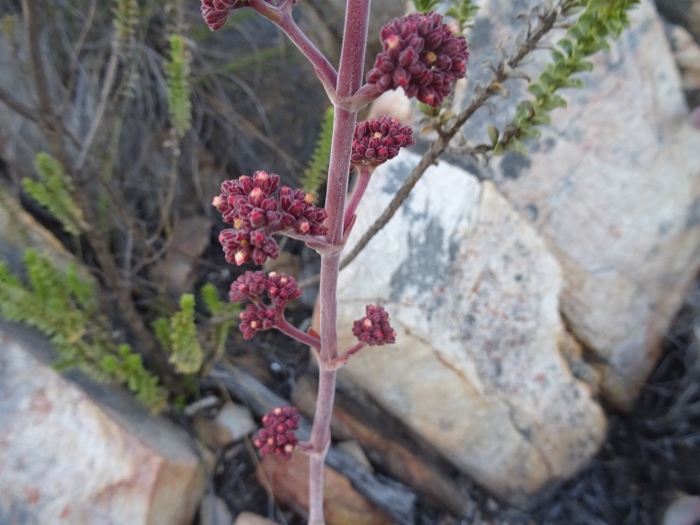Silver Crassula
(Crassula cotyledonis)
Silver Crassula (Crassula cotyledonis)
/
/

Paul Hoekman
CC BY 4.0
Image By:
Paul Hoekman
Recorded By:
Copyright:
CC BY 4.0
Copyright Notice:
Photo by: Paul Hoekman | License Type: CC BY 4.0 | License URL: http://creativecommons.org/licenses/by/4.0/ | Rights Holder: Paul Hoekman | Publisher: iNaturalist | Date Created: 2021-01-02T19:25:50-08:00 |

























Estimated Native Range
Summary
Crassula cotyledonis, commonly known as the Silver Crassula, is a succulent plant native to the arid regions of Namaqualand and the Karoo in South Africa, as well as extending into Namibia. It is adapted to rocky outcrops, hilltops, and slopes, thriving in well-drained soils. This species forms a low, sparse rosette with tiny, woody stems and light grey-green, pubescent (hairy) leaves that help it conserve water. The Silver Crassula blooms with closed-tubular flowers that are small and held in rounded clusters on elongated stems up to 6 inches tall. Flowering occurs from late winter to spring, and the flowers are not particularly showy, but they do add a subtle charm to the plant.
In cultivation, Crassula cotyledonis is valued for its drought tolerance and unique foliage texture, making it a suitable choice for rock gardens, succulent collections, and as a ground cover in xeriscapes. It requires minimal maintenance, thriving in full sun to partial shade and needing only occasional watering once established. It is important to plant it in well-draining soil to prevent root rot. While it is not known for significant pest or disease issues, overwatering can lead to problems. It is not typically grown for its flowers, but rather for its foliage and form.CC BY-SA 4.0
In cultivation, Crassula cotyledonis is valued for its drought tolerance and unique foliage texture, making it a suitable choice for rock gardens, succulent collections, and as a ground cover in xeriscapes. It requires minimal maintenance, thriving in full sun to partial shade and needing only occasional watering once established. It is important to plant it in well-draining soil to prevent root rot. While it is not known for significant pest or disease issues, overwatering can lead to problems. It is not typically grown for its flowers, but rather for its foliage and form.CC BY-SA 4.0
Plant Description
- Plant Type: Succulent
- Height: 0.5-1 feet
- Width: 0.5-1 feet
- Growth Rate: Moderate
- Flower Color: N/A
- Flowering Season: Summer
- Leaf Retention: Evergreen
Growth Requirements
- Sun: Part Shade
- Water: Low, Medium
- Drainage: Fast, Medium
Common Uses
Drought Tolerant, Fire Resistant, Low Maintenance, Potted Plant, Rock Garden
Natural Habitat
Native to arid regions of Namaqualand and the Karoo in South Africa, and extending into Namibia, on rocky outcrops, hilltops, and slopes
Other Names
Common Names: Red Crassula, Airplane Plant
Scientific Names: , Crassula cotyledonis, Crassula canescens, Crassula canescens var. latifolia, Crassula cephalophora var. dubia, Crassula cephalophora var. taylori, Crassula cephalophora var. tayloriae, Crassula cotyledon, Crassula dubia, Crassula rehmannii
GBIF Accepted Name: